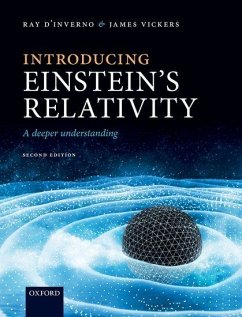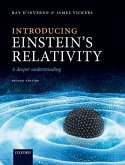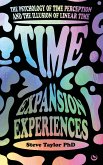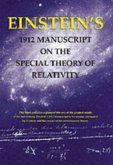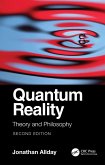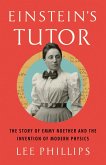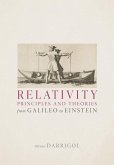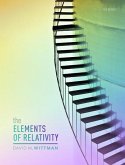Ray d'Inverno (Emeritus Professor, Emeritus Professor, University o, James Vickers (Emeritus Professor, Emeritus Professor, University o
Introducing Einstein's Relativity
A Deeper Understanding
Ray d'Inverno (Emeritus Professor, Emeritus Professor, University o, James Vickers (Emeritus Professor, Emeritus Professor, University o
Introducing Einstein's Relativity
A Deeper Understanding
- Gebundenes Buch
- Merkliste
- Auf die Merkliste
- Bewerten Bewerten
- Teilen
- Produkt teilen
- Produkterinnerung
- Produkterinnerung
This textbook provides students with a sound mathematical introduction coupled to an understanding of the physical insights needed to explore the subject
Andere Kunden interessierten sich auch für
![Introducing Einstein's Relativity Introducing Einstein's Relativity]() Ray d'Inverno (Emeritus Professor, Emeritus Professor, University oIntroducing Einstein's Relativity70,99 €
Ray d'Inverno (Emeritus Professor, Emeritus Professor, University oIntroducing Einstein's Relativity70,99 €![Time Expansion Experiences Time Expansion Experiences]() Steve TaylorTime Expansion Experiences22,99 €
Steve TaylorTime Expansion Experiences22,99 €![Einstein's 1912 Manuscript on the Special Theory of Relativity Einstein's 1912 Manuscript on the Special Theory of Relativity]() Einstein's 1912 Manuscript on the Special Theory of Relativity28,99 €
Einstein's 1912 Manuscript on the Special Theory of Relativity28,99 €![Quantum Reality Quantum Reality]() Jonathan AlldayQuantum Reality66,99 €
Jonathan AlldayQuantum Reality66,99 €![Einstein's Tutor Einstein's Tutor]() Lee PhillipsEinstein's Tutor22,33 €
Lee PhillipsEinstein's Tutor22,33 €![Relativity Principles and Theories from Galileo to Einstein Relativity Principles and Theories from Galileo to Einstein]() Olivier Darrigol (Research Director at CNRS and Research Scholar atRelativity Principles and Theories from Galileo to Einstein75,99 €
Olivier Darrigol (Research Director at CNRS and Research Scholar atRelativity Principles and Theories from Galileo to Einstein75,99 €![The Elements of Relativity The Elements of Relativity]() David M. Wittman (Professor, University of California, Davis)The Elements of Relativity94,99 €
David M. Wittman (Professor, University of California, Davis)The Elements of Relativity94,99 €-
-
-
This textbook provides students with a sound mathematical introduction coupled to an understanding of the physical insights needed to explore the subject
Hinweis: Dieser Artikel kann nur an eine deutsche Lieferadresse ausgeliefert werden.
Hinweis: Dieser Artikel kann nur an eine deutsche Lieferadresse ausgeliefert werden.
Produktdetails
- Produktdetails
- Verlag: Oxford University Press
- 2 Revised edition
- Seitenzahl: 624
- Erscheinungstermin: 7. September 2022
- Englisch
- Abmessung: 252mm x 196mm x 35mm
- Gewicht: 1480g
- ISBN-13: 9780198862024
- ISBN-10: 0198862024
- Artikelnr.: 62045648
- Herstellerkennzeichnung
- Libri GmbH
- Europaallee 1
- 36244 Bad Hersfeld
- gpsr@libri.de
- Verlag: Oxford University Press
- 2 Revised edition
- Seitenzahl: 624
- Erscheinungstermin: 7. September 2022
- Englisch
- Abmessung: 252mm x 196mm x 35mm
- Gewicht: 1480g
- ISBN-13: 9780198862024
- ISBN-10: 0198862024
- Artikelnr.: 62045648
- Herstellerkennzeichnung
- Libri GmbH
- Europaallee 1
- 36244 Bad Hersfeld
- gpsr@libri.de
Professor Ray d'Inverno is Emeritus Professor in General Relativity at the University of Southhampton. A pioneer in the use of computer algebra in general relativity, Professor d'Inverno developed the early system LAM (Lisp Algebraic Manipulator), which was a precursor to Sheep, the system most used to date in the study of exact solutions and their invariant classification. He also developed the 2+2 formalism for analysing the initial value problem in general relativity. The formalism has also been used to provide a possible route towards a canonical quantization programme for the theory. In addition, he worked in numerical relativity (solving Einstein's equations numerically on a computer) and with others set up the CCM (Cauchy-Characteristic Matching) approach, which is still used in this increasingly important field. James Vickers is an Emeritus Professor of Mathematics at the University of Southampton and has published extensively on general relativity. His early research was on the structure of weak singularities in relativity and more recently he has given proofs of both the Penrose and Hawking singularity theorems for low-regularity spacetimes. These show that the singularities predicted by these theorems must be accompanied by unbounded curvature. He has also worked on the asymptotic structure of space-time and used spinors to prove the positivity of the Bondi mass.
1: The Organisation of the Book
A: Special Relativity
2: The k-Calculus
3: The Key Attributes of Special Relativity
4: The Elements of Relativistic Mechanics
B: The Formalism of Tensors
5: Tensor Algebra
6: Tensor Calculus
7: Integration, Variation, and Symmetry
C: General Relativity
8: Special Relativity Revisited
9: The Principles of General Relativity
10: The Field equations of General Relativity
11: General Relativity from a Variational Principle
12: The Energy-Momentum Tensor
13: The Structure of the Field Equations
14: The 3+1 and 2+2 Formalisms
15: The Schwarzschild sSlution
16: Classical Experimental Tests of General Relativity
D: Black Holes
17: Non-Rotating Black Holes
18: Maximal Extension and Conformal Compactification
19: Charged Black Holes
20: Rotating Black Holes
E: Gravitational Waves
21: Linearized Gravitational Waves and their Detection
22: Exact Gravitational Waves
23: Radiation from an Isolated Source
F: Cosmology
24: Relativistic Cosmology
25: The Classical Cosmological Models
26: Modern Cosmology
Answers to Exercises
Selected Bibliography
Index
A: Special Relativity
2: The k-Calculus
3: The Key Attributes of Special Relativity
4: The Elements of Relativistic Mechanics
B: The Formalism of Tensors
5: Tensor Algebra
6: Tensor Calculus
7: Integration, Variation, and Symmetry
C: General Relativity
8: Special Relativity Revisited
9: The Principles of General Relativity
10: The Field equations of General Relativity
11: General Relativity from a Variational Principle
12: The Energy-Momentum Tensor
13: The Structure of the Field Equations
14: The 3+1 and 2+2 Formalisms
15: The Schwarzschild sSlution
16: Classical Experimental Tests of General Relativity
D: Black Holes
17: Non-Rotating Black Holes
18: Maximal Extension and Conformal Compactification
19: Charged Black Holes
20: Rotating Black Holes
E: Gravitational Waves
21: Linearized Gravitational Waves and their Detection
22: Exact Gravitational Waves
23: Radiation from an Isolated Source
F: Cosmology
24: Relativistic Cosmology
25: The Classical Cosmological Models
26: Modern Cosmology
Answers to Exercises
Selected Bibliography
Index
1: The Organisation of the Book
A: Special Relativity
2: The k-Calculus
3: The Key Attributes of Special Relativity
4: The Elements of Relativistic Mechanics
B: The Formalism of Tensors
5: Tensor Algebra
6: Tensor Calculus
7: Integration, Variation, and Symmetry
C: General Relativity
8: Special Relativity Revisited
9: The Principles of General Relativity
10: The Field equations of General Relativity
11: General Relativity from a Variational Principle
12: The Energy-Momentum Tensor
13: The Structure of the Field Equations
14: The 3+1 and 2+2 Formalisms
15: The Schwarzschild sSlution
16: Classical Experimental Tests of General Relativity
D: Black Holes
17: Non-Rotating Black Holes
18: Maximal Extension and Conformal Compactification
19: Charged Black Holes
20: Rotating Black Holes
E: Gravitational Waves
21: Linearized Gravitational Waves and their Detection
22: Exact Gravitational Waves
23: Radiation from an Isolated Source
F: Cosmology
24: Relativistic Cosmology
25: The Classical Cosmological Models
26: Modern Cosmology
Answers to Exercises
Selected Bibliography
Index
A: Special Relativity
2: The k-Calculus
3: The Key Attributes of Special Relativity
4: The Elements of Relativistic Mechanics
B: The Formalism of Tensors
5: Tensor Algebra
6: Tensor Calculus
7: Integration, Variation, and Symmetry
C: General Relativity
8: Special Relativity Revisited
9: The Principles of General Relativity
10: The Field equations of General Relativity
11: General Relativity from a Variational Principle
12: The Energy-Momentum Tensor
13: The Structure of the Field Equations
14: The 3+1 and 2+2 Formalisms
15: The Schwarzschild sSlution
16: Classical Experimental Tests of General Relativity
D: Black Holes
17: Non-Rotating Black Holes
18: Maximal Extension and Conformal Compactification
19: Charged Black Holes
20: Rotating Black Holes
E: Gravitational Waves
21: Linearized Gravitational Waves and their Detection
22: Exact Gravitational Waves
23: Radiation from an Isolated Source
F: Cosmology
24: Relativistic Cosmology
25: The Classical Cosmological Models
26: Modern Cosmology
Answers to Exercises
Selected Bibliography
Index

